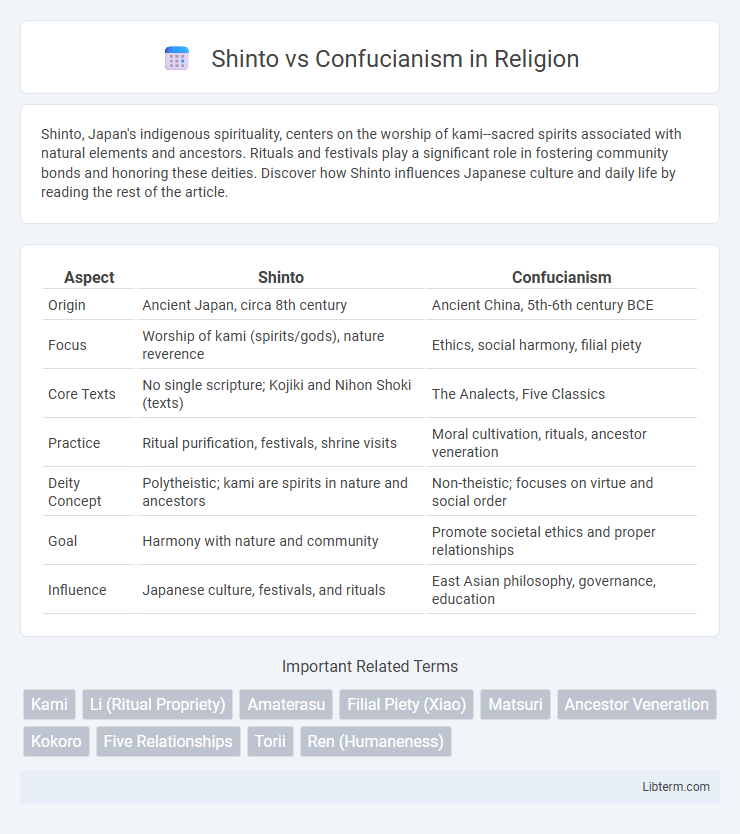Shinto, Japan's indigenous spirituality, centers on the worship of kami--sacred spirits associated with natural elements and ancestors. Rituals and festivals play a significant role in fostering community bonds and honoring these deities. Discover how Shinto influences Japanese culture and daily life by reading the rest of the article.
Table of Comparison
| Aspect | Shinto | Confucianism |
|---|---|---|
| Origin | Ancient Japan, circa 8th century | Ancient China, 5th-6th century BCE |
| Focus | Worship of kami (spirits/gods), nature reverence | Ethics, social harmony, filial piety |
| Core Texts | No single scripture; Kojiki and Nihon Shoki (texts) | The Analects, Five Classics |
| Practice | Ritual purification, festivals, shrine visits | Moral cultivation, rituals, ancestor veneration |
| Deity Concept | Polytheistic; kami are spirits in nature and ancestors | Non-theistic; focuses on virtue and social order |
| Goal | Harmony with nature and community | Promote societal ethics and proper relationships |
| Influence | Japanese culture, festivals, and rituals | East Asian philosophy, governance, education |
Introduction to Shinto and Confucianism
Shinto is an indigenous Japanese religion centered on kami, sacred spirits associated with natural phenomena and ancestors, emphasizing rituals and purity. Confucianism, originating from China, is a philosophical system focusing on ethics, social harmony, and proper conduct based on the teachings of Confucius. Both have deeply influenced East Asian culture, with Shinto shaping Japanese spirituality and Confucianism providing a moral and social framework.
Historical Origins and Development
Shinto, indigenous to Japan, originated as an ancient animistic belief system centered on kami worship and rituals that fostered a deep connection between nature and ancestors. Confucianism, founded by Confucius in China during the 6th century BCE, developed as a philosophical and ethical framework emphasizing social harmony, moral conduct, and hierarchical relationships. While Shinto evolved primarily through indigenous practices and state rituals in Japan, Confucianism influenced East Asian societies through classical texts and was integrated into governance and education systems over centuries.
Core Beliefs and Philosophical Foundations
Shinto centers on kami worship, emphasizing harmony with nature, ancestral reverence, and ritual purification, reflecting its animistic and polytheistic roots. Confucianism prioritizes ethical conduct, social harmony, filial piety, and hierarchical relationships grounded in humaneness (ren) and righteousness (yi). While Shinto integrates spirituality with Japanese identity and mythological tradition, Confucianism offers a pragmatic, moral philosophy shaping social order and governance.
Key Deities and Spiritual Figures
Shinto centers on kami, which are spirits or deities representing natural forces, ancestors, and sacred phenomena, with Amaterasu, the sun goddess, being one of its principal deities. Confucianism, in contrast, does not focus on deities but highlights spiritual figures like Confucius himself, revered for his teachings on ethics, human virtue, and social harmony. Shinto rituals aim to honor and appease the kami, while Confucian practices emphasize ancestral veneration and moral cultivation without worship of supernatural beings.
Rituals, Practices, and Ceremonies
Shinto rituals emphasize purification, offerings, and festivals honoring kami, reflecting a deep connection to nature and ancestral spirits, with ceremonies often held at shrines involving chanting, prayer, and sacred dances. Confucian practices center on ancestor worship, moral rites, and formal ceremonies that reinforce social hierarchy and filial piety, frequently performed during festivals and family gatherings using prescribed rituals to cultivate virtue and social harmony. While Shinto ceremonies highlight spiritual cleansing and reverence for natural forces, Confucian rituals focus on ethical conduct and maintaining order within society through structured rites.
Moral Codes and Ethical Principles
Shinto emphasizes harmony with nature, purity, and reverence for kami, promoting moral codes centered on sincerity, respect, and ritual cleanliness. Confucianism focuses on hierarchical relationships, filial piety, and social harmony, advocating virtues like righteousness, loyalty, and benevolence as essential ethical principles. Both systems influence Japanese culture, with Shinto providing spiritual rituals and Confucianism guiding social ethics and governance.
Influence on Society and Culture
Shinto emphasizes ritual purity, ancestor worship, and harmony with nature, deeply influencing Japanese festivals, architecture, and community cohesion. Confucianism, rooted in ethical teachings and social hierarchy, shapes moral values, education, and governance across East Asia, especially in China, Korea, and Vietnam. Both systems contribute to social stability, with Shinto fostering spiritual identity and Confucianism promoting disciplined societal order.
Worship Spaces and Sacred Symbols
Shinto worship spaces, known as shrines (jinja), are characterized by torii gates marking sacred boundaries and honden sanctuaries housing kami (spirits), emphasizing natural elements like trees and water as sacred symbols. Confucianism centers its rituals in ancestral temples or family altars, where incense burners and tablets inscribed with ancestors' names serve as key symbols representing filial piety and respect for lineage. The contrast between Shinto's focus on nature-based kami worship and Confucianism's ritual veneration of ancestors reflects their differing spiritual and cultural priorities in East Asia.
Modern Interpretations and Relevance
Modern interpretations of Shinto emphasize its role in cultural identity and nature reverence, influencing contemporary environmental movements in Japan. Confucianism's principles of social harmony and ethical governance remain integral in East Asian educational systems and corporate cultures. Both traditions adapt to modern contexts by blending ancient wisdom with globalized values, sustaining relevance in societal and political frameworks.
Major Differences and Similarities
Shinto centers on the worship of kami and emphasizes rituals and festivals linked to nature and ancestors, while Confucianism prioritizes ethical conduct, social harmony, and hierarchical relationships based on filial piety and loyalty. Both traditions value respect for ancestors and contribute to shaping Japanese cultural identity, yet Shinto is primarily a native spirituality tied to shrine practices, whereas Confucianism is a philosophical and moral system originating from China. The coexistence of Shinto rituals with Confucian ethical principles illustrates their complementary roles in personal and societal life.
Shinto Infographic

 libterm.com
libterm.com